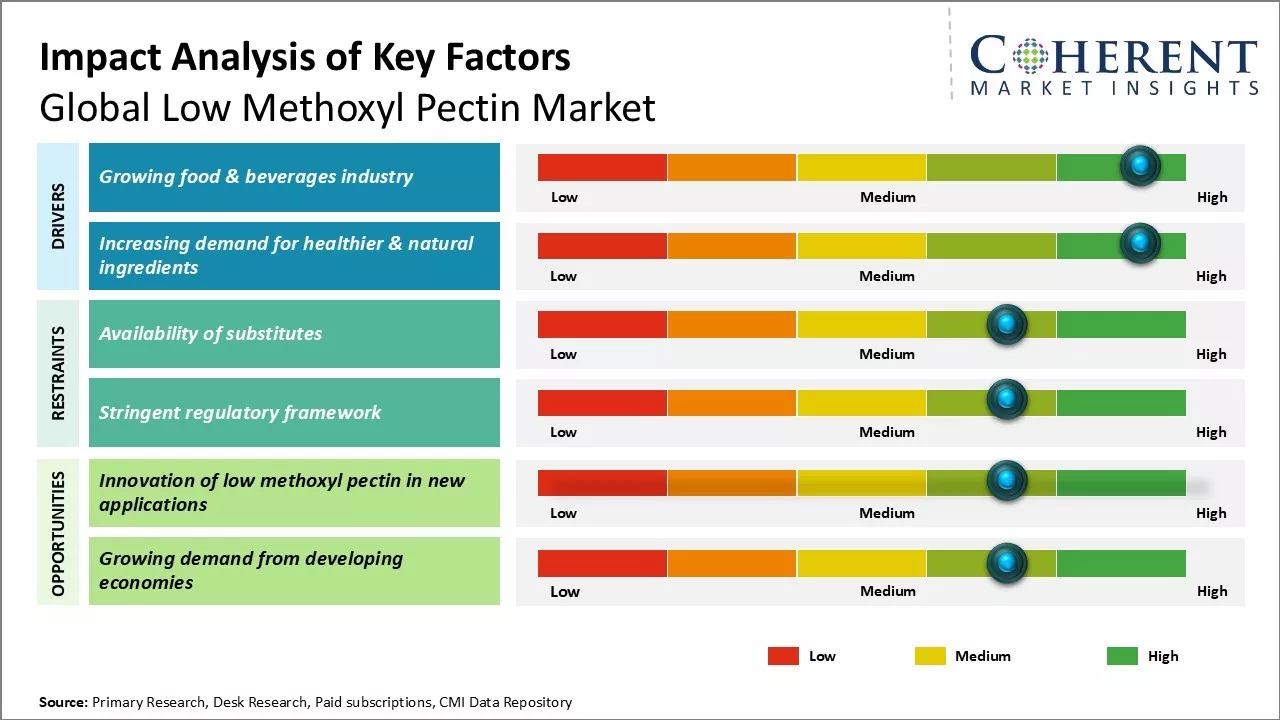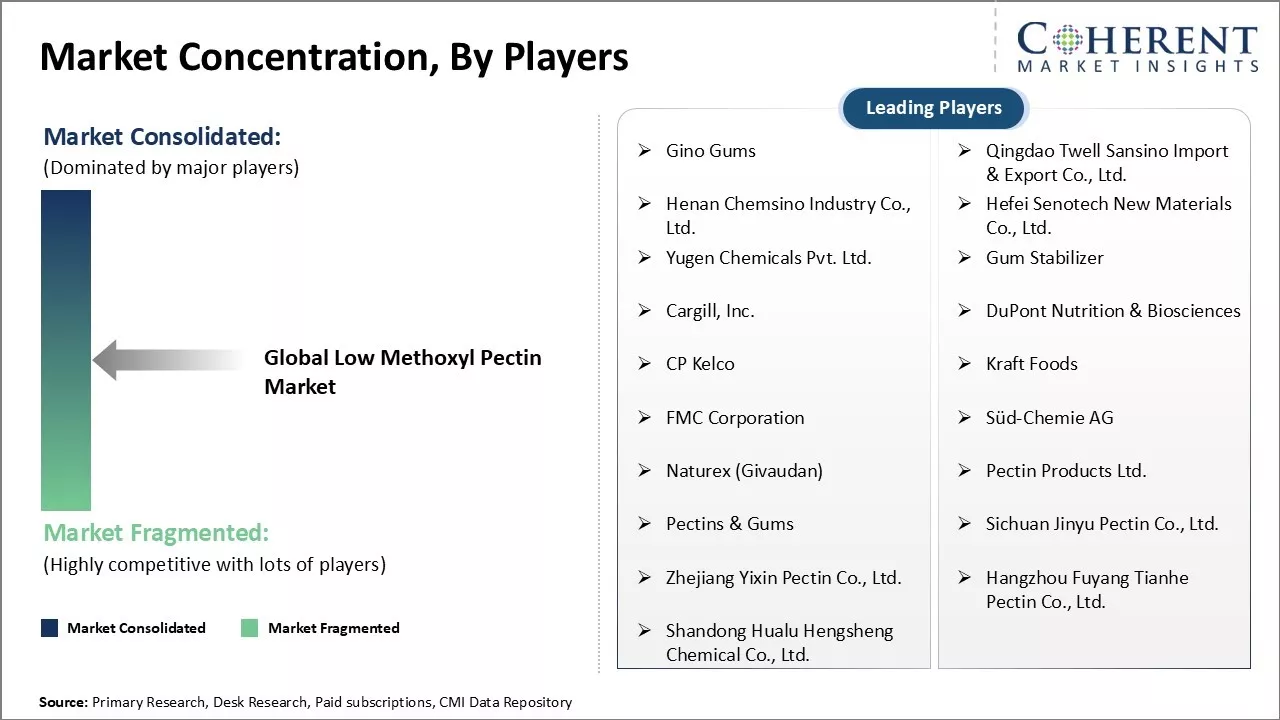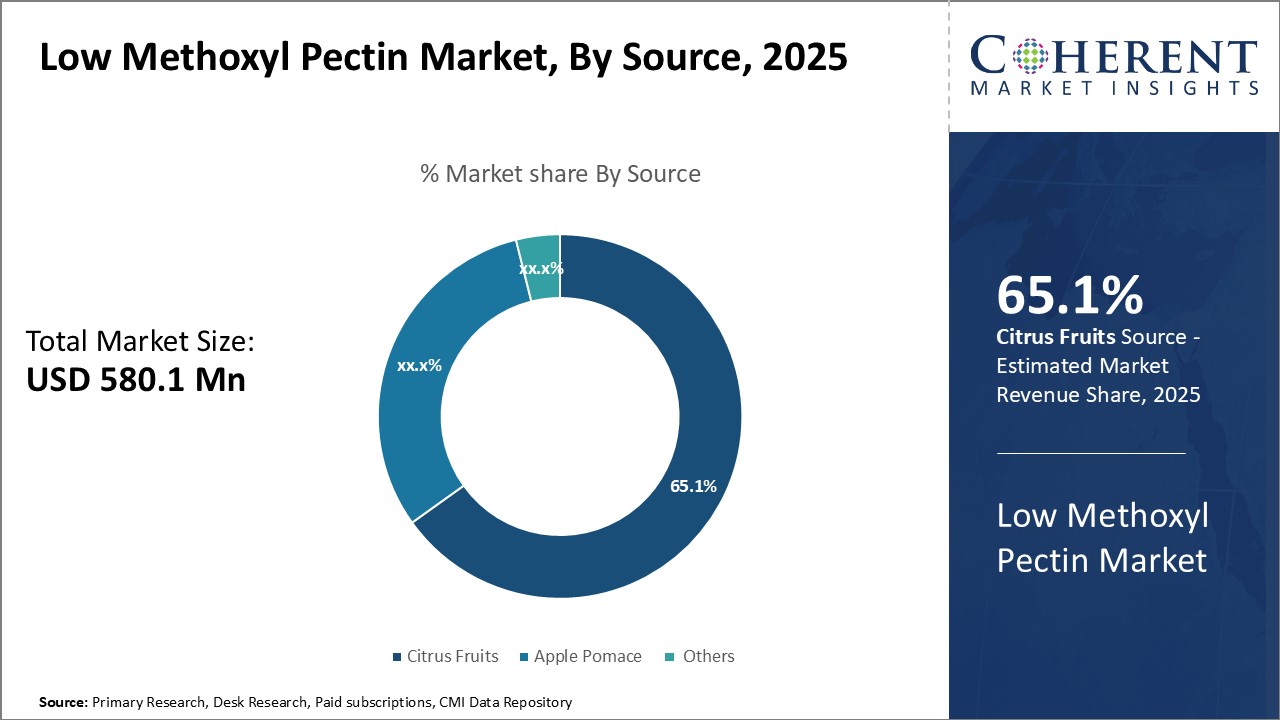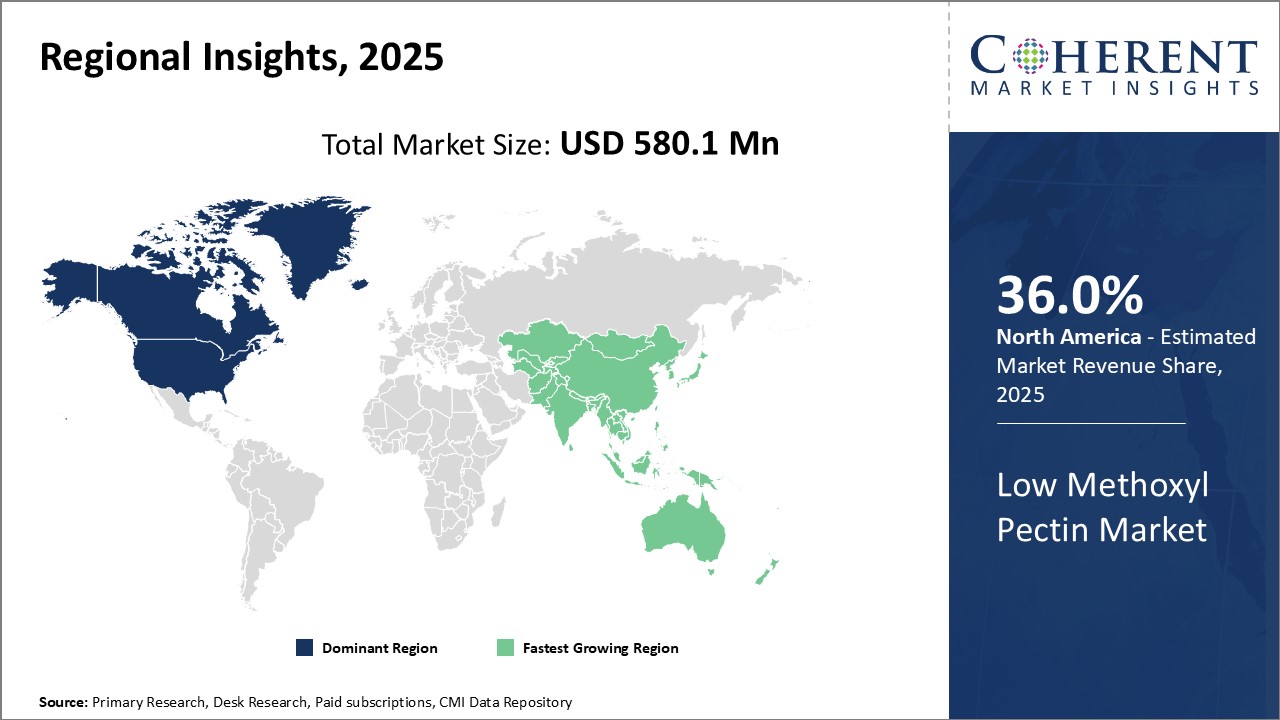Low Methoxyl Pectin Market Size and Trends
The global low methoxyl pectin market is estimated to be valued at USD 580.1 Mn in 2025 and is expected to reach USD 982.1 Mn by 2032, exhibiting a compound annual growth rate (CAGR) of 7.8% from 2025 to 2032.

Discover market dynamics shaping the industry: Download Free Sample
The increasing use of low methoxyl pectin as a stabilizer, thickener, and gelling agent in various food applications, such as bakery fillings, dairy products, and other beverages, is driving the demand for low methoxyl pectin. Low methoxyl pectin is considered a substitute for sugar and fat in reduced calorie food products owing to its texturizing properties. This is expected to provide opportunities for growth in the low methoxyl pectin market during the forecast period.
Market Driver - Growing food & beverages industry
The global food and beverages industry has seen substantial growth over the past few decades. Rapid urbanization, growing middle class population, and changing lifestyles have been key growth drivers. As people's disposable incomes rise, they are willing to spend more on processed, packaged, and ready-to-eat foods. This has created opportunities for food companies to innovate and introduce numerous new product varieties into the market.
Low methoxyl pectin plays an important role as a gelling, thickening, and stabilizing agent in many food and beverage products. It is commonly used in jams, jellies, fruit spreads, desserts, dairy products, and various beverages. With increasing consumption of these packaged food categories, the demand for functional ingredients like low methoxyl pectin has risen steadily. Food makers rely on it to provide a good texture and shelf stability to products without compromising on the taste. It allows them to launch innovative packages and on-the-go consumption options.
Evolving dietary trends have also supported this growth. Consumers now prefer healthier choices and are more health conscious. They seek out products with clean labels and fewer artificial additives. Low methoxyl pectin addresses these needs well as it is derived from citrus fruits and apples and has no undesirable chemical components. Its natural credentials help brands to formulate and market food items as being more nutritious. This clean image acts as a unique selling point in the premium segment.
The urban population across emerging nations like India, China, Brazil, etc. have become more affluent and brand conscious over the past decade. International food companies have increased their focus on these regions seeing lucrative prospects. Their aggressive marketing strategies and wide distribution have augmented the food consumption patterns here. As lifestyle diseases rise, people also want convenient packaged foods that improve their quality of life. This expanding the consumer base of these developing markets will continue to drive the low methoxyl pectin market.
Market Concentration and Competitive Landscape

Get actionable strategies to beat competition: Download Free Sample
Increasing demand for healthier & natural ingredients
Consumers globally have become increasingly health conscious in their food choices. There is a growing need for minimally processed, additive-free and natural products. This consumer demand for 'clean label' items has compelled food manufacturers to revamp their formulations. They are under pressure to replace chemical preservatives, thickeners, and stabilizers with more natural alternatives that also offer the desired functional benefits.
Low methoxyl pectin checks all right boxes here. It improves texture, lengthens shelf life and gels effectively without compromising taste like other hydrocolloids. At the same time, it can be categorized as a 'natural ingredient' since it naturally occurs in citrus fruits and apples. This has made it a popular clean label thickener/gelling agent across various food categories like yogurt, fruit spreads, baked goods, soups, etc.
The regulatory landscape is also evolving to support natural ingredients. Stricter norms for synthetic chemicals and additives give an advantage to more natural hydrocolloids. Organizations like Non-GMO Project and Cosmos-standard have added credibility to some naturally derived ingredients. Manufacturers seek clean label certifications to gain consumer confidence and market their products as 'natural'. Low methoxyl pectin offers the function without labeling hassles compared to certain gums and starches.
Customers have risen health issues linked to excessive sugar and calorie intake. They prefer dietary fibers, whole grains, and similar ingredients known to offer nutritional benefits. Low methoxyl pectin is rich in fiber content and helps in improving digestion. High fiber, natural, and low-calorie positioning allows companies to pitch products made using it, as part of a balanced diet and lifestyle. This increased focus on nutrition and wellness will ensure that the natural clean label ingredients stay relevant hence driving the low methoxyl pectin market growth.
Key Takeaways from Analyst:
The global low methoxyl pectin market is poised to grow steadily driven by increasing health awareness among consumers. Pectin is widely used as a stabilizer and thickener in various food and beverage applications due to its gelling and texturing properties. The rising demand for low-calorie and low-sugar products will boost the demand for low methoxyl pectin. Food manufacturers are also innovating with low methoxyl pectin to offer clean-label products.
However, volatile prices of raw materials used for extracting pectin can hamper the market growth. The COVID-19 pandemic also disrupted supply chains, impacting production. North America currently dominates global sales as consumers in countries like the U.S. and Canada show high demand for use in dairy products and juices. Asia Pacific is expected to be the fastest-growing regional market with India and China witnessing increased uptake.
Key players are investing in R&D to develop low methoxyl pectin products suitable for new application areas like bakery, confectionery, and personal care. They are also focusing on business expansion in emerging economies through capacity expansion and partnerships. The market is expected to see more product launches catering to the vegan and organic trends.
Market Challenge - Availability of substitutes
The global low methoxyl pectin market faces significant challenges due to the availability of substitutes in the market. Low methoxyl pectin is widely used in the food and beverages industry as a gelling agent, stabilizer, and thickening agent. However, there are several substitutes available that can be used for similar applications. For example, guar gum, xanthan gum, carrageenan, and other hydrocolloids can be effectively used in place of low methoxyl pectin. The easy availability and comparable properties of these substitute products has enabled food manufacturers to switch to alternative solutions. This substitutability increases competition and puts pricing pressure on low methoxyl pectin producers. For the market to continue growing, players must focus on differentiating their product and promote advantages of low methoxyl pectin over alternatives through innovative applications and value-added formulations.
Market Opportunity - Innovation of low methoxyl pectin in new applications
The global low methoxyl pectin market provides opportunities for players who focus on innovation and application development. While low methoxyl pectin is predominantly used in the food and beverage industry currently, there exists scope to expand its usage to new application areas. One promising avenue is exploring the usage of low methoxyl pectin in personal care and cosmetics products. Its film forming, stabilizing, and texture enhancing properties can help develop innovative formulations for products like sunscreens, makeup bases, moisturizers, etc. Similarly, its gelling properties can help devise gels and emulsions. Efforts to introduce low methoxyl pectin in pharmaceuticals, mainly for tableting and modified drug release also needs to be expended. Innovation in product positioning through novel application development can help drive new demand and counter challenges from substitutes in existing markets.

Discover high revenue pocket segments and roadmap to it: Download Free Sample
Insights by source: Widespread cultivation and natural suitability
In terms of source, citrus fruits are expected to contribute 65.1% share of the marketwing to their widespread cultivation and natural suitability. Citrus fruits such as oranges, lemons, and limes have high levels of pectin in their peels and pulp. Pectin extraction from citrus fruit peels is a well-established process that provides a consistent and quality source of low methoxyl pectin. The global citrus belt spans major fruit producing nations, allowing for a year-round supply of raw materials. Optimized agricultural and extraction practices have lowered production costs. As the leading citrus producers, Brazil, the U.S., and Mexico export fruit peels globally for pectin extraction. The sustainability of citrus cultivation additionally boosts its market dominance over other sources.
Insights by application: Extensive usage of low methoxyl pectin
In terms of application, food and beverages is expected to contribute 48.2% of the market share in 2025, owing to the extensive usage of low methoxyl pectin as a gelling, thickening, and stabilizing agent. Properties like gelling over a wide pH range and in the presence of sugars and acids make it particularly suitable for various food applications. It is widely used in jams, jellies, fruit fillings, and dairy products to control crystallization. In beverages, it provides stability in fruit juices and drinks. The thriving processed and packaged food industry relies on functional ingredients like low methoxyl pectin to manufacture an array of products while meeting labeling and certification standards. As consumption trends shift towards healthier and natural foods, the demand for low methoxyl pectin as a clean label ingredient in the largest food and beverage market remains robust.
Regional Insights

Need a Different Region or Segment? Download Free Sample
The North America region has established itself as the undisputed leader in the global low methoxyl pectin market. The region is expected to hold 36.0% of the market share in 2025. The presence of key players like CP Kelco and Golden Health has cemented North America's position at the top. These companies have extensive operations and manufacturing facilities across the region to cater to the growing demand. With applications in food and beverages being the major end-use, North America also benefits from its developed food processing industry.
Stringent regulatory norms regarding food ingredients and additives in countries like the U.S. and Canada have propelled the demand for low methoxyl pectin. Its widespread usage in fulfilling labelling claims like 'all-natural' or 'no artificial ingredients' has made it a vital component in many commercial food items. The region also has a highly health-conscious population constantly driving innovations involving natural ingredients like low methoxyl pectin in various foods and beverages. All these factors have collectively aided North America in establishing its strong dominance.
The Asia Pacific region has emerged as the fastest expanding market for low methoxyl pectin globally. Countries like China and India offer massive prospects due to their rapidly developing food processing sectors and rising health consciousness. A burgeoning middle class with increasing disposable incomes is also looking for premium packaged foods with natural ingredients. This changing consumption pattern has opened new avenues for low methoxyl pectin usage.
Simultaneously, the region has witnessed a surge in exports and imports of low methoxyl pectin owing to its wide applications across countries. Major players have set up production facilities in Asia Pacific to cater to the proliferating demand. Its usage as a stabilizing, thickening, and gelling agent in beverages and dairy products has spurred consumption. Overall, the lucrative growth opportunities presented by Asia Pacific's evolving food culture and industrial progression make it the most rapidly ascending low methoxyl pectin market worldwide.
Market Report Scope
Low Methoxyl Pectin Market Report Coverage
| Report Coverage | Details | ||
|---|---|---|---|
| Base Year: | 2024 | Market Size in 2025: | USD 580.1 Mn |
| Historical Data for: | 2020 To 2024 | Forecast Period: | 2025 To 2032 |
| Forecast Period 2025 to 2032 CAGR: | 7.8% | 2032 Value Projection: | USD 982.1 Mn |
| Geographies covered: |
|
||
| Segments covered: |
|
||
| Companies covered: |
Gino Gums, Qingdao Twell Sansino Import & Export Co., Ltd., Henan Chemsino Industry Co., Ltd., Hefei Senotech New Materials Co., Ltd., Yugen Chemicals Pvt. Ltd., Gum Stabilizer, Cargill, Inc., DuPont Nutrition & Biosciences, CP Kelco, Kraft Foods, FMC Corporation, Süd-Chemie AG, Naturex (Givaudan), Pectin Products Ltd., Pectins & Gums, Sichuan Jinyu Pectin Co., Ltd., Zhejiang Yixin Pectin Co., Ltd., Hangzhou Fuyang Tianhe Pectin Co., Ltd., and Shandong Hualu Hengsheng Chemical Co., Ltd. |
||
| Growth Drivers: |
|
||
| Restraints & Challenges: |
|
||
Uncover macros and micros vetted on 75+ parameters: Get instant access to report
Low Methoxyl Pectin Industry News
- In January 2024, International Flavors & Fragrances (IFF) introduced Grindsted Pectin FB 420, a new product specifically designed for baking applications. This innovative pectin offers several benefits for the baking industry, including unique sensory qualities, label-friendliness, and process efficiency.
- In December 2023, Herbstreith & Fox GmbH & Co. KG announced the establishment of a new subsidiary, H&F Italy SRL, located in Milan, Italy. This strategic move underscores the H&F Group's commitment to expanding its presence and enhancing its operations in the Italian market.
- In 2023, Cargill announced the introduction of a new range of Low Methoxyl (LM) Conventional (LMC) pectin, designed to meet the evolving needs of the food and beverage industry. This innovative product line aims to provide manufacturers with versatile solutions for various applications, particularly in fruit-based products.
*Definition: The global low methoxyl pectin market consists of manufacturers and suppliers of low methoxyl pectin used extensively in various food and beverage applications as a gelling and thickening agent. Low methoxyl pectin (LMP) has a low degree of esterification (below 50%), which allows it to form gels in the presence of acids, sugars, and calcium ions. It is used in products like fruit spreads, fruit juices, dairy, bakery, and others. The global market has been growing in recent years due to rising health-consciousness and increasing demand for healthy and natural food products.
Market Segmentation
- Source Insights (Revenue, USD Mn, 2020 - 2032)
-
- Citrus Fruits
- Apple Pomace
- Others
- Application Insights (Revenue, USD Mn, 2020 - 2032)
-
- Food and Beverages
- Pharmaceuticals
- Cosmetics and Personal Care
- Others (Agriculture, etc.)
- Regional Insights (Revenue, USD Bn, 2020 - 2032)
-
- North America
- U.S.
- Canada
- Latin America
- Brazil
- Argentina
- Mexico
- Rest of Latin America
- Europe
- Germany
- U.K.
- Spain
- France
- Italy
- Russia
- Rest of Europe
- Asia Pacific
- China
- India
- Japan
- Australia
- South Korea
- ASEAN
- Rest of Asia Pacific
- Middle East
- GCC Countries
- Israel
- Rest of Middle East
- Africa
- South Africa
- North Africa
- Central Africa
- North America
- Key Players Insights
- Gino Gums
- Qingdao Twell Sansino Import & Export Co., Ltd.
- Henan Chemsino Industry Co., Ltd.
- Hefei Senotech New Materials Co., Ltd.
- Yugen Chemicals Pvt. Ltd.
- Gum Stabilizer
- Cargill, Inc.
- DuPont Nutrition & Biosciences
- CP Kelco
- Kraft Foods
- FMC Corporation
- Süd-Chemie AG
- Naturex (Givaudan)
- Pectin Products Ltd.
- Pectins & Gums
- Sichuan Jinyu Pectin Co., Ltd.
- Zhejiang Yixin Pectin Co., Ltd.
- Hangzhou Fuyang Tianhe Pectin Co., Ltd.
- Shandong Hualu Hengsheng Chemical Co., Ltd.
Share
Share
About Author
Yash Doshi is a Senior Management Consultant. He has 12+ years of experience in conducting research and handling consulting projects across verticals in APAC, EMEA, and the Americas.
He brings strong acumen in helping chemical companies navigate complex challenges and identify growth opportunities. He has deep expertise across the chemicals value chain, including commodity, specialty and fine chemicals, plastics and polymers, and petrochemicals. Yash is a sought-after speaker at industry conferences and contributes to various publications on topics related commodity, specialty and fine chemicals, plastics and polymers, and petrochemicals.
Missing comfort of reading report in your local language? Find your preferred language :
Transform your Strategy with Exclusive Trending Reports :
Frequently Asked Questions
EXISTING CLIENTELE
Joining thousands of companies around the world committed to making the Excellent Business Solutions.
View All Our Clients
